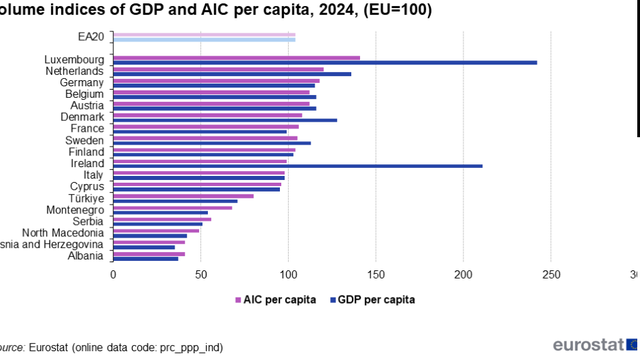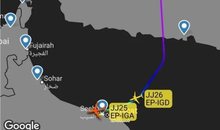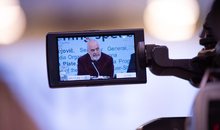
 Flash News
Flash News
Iran faces near-total internet blackout
Accident on the Grand Ring Road, two cars collide
They supplied fuel to vessels without using a fiscal cash register, 2 people are being prosecuted in Himara
Accident on the Manzë - Gjiri i Lalzit axis, 4 young people injured, one of them in serious condition
Evacuation of 5 Albanians from Israel, 3 of them arrive in Albania
Population decline doesn't help, Albania last in Europe for per capita income even in 2024

Albania continued to remain last in Europe in terms of per capita income measured by purchasing power for goods and services, even in 2024, despite the country's population being reduced by more than 400 thousand people, dropping to 2.4 million inhabitants according to the 2023 census.
Although the country has had satisfactory growth in recent years and there are fewer people to whom the value of goods produced in a year is distributed, the well-being of individuals does not appear to have increased, also affected by relatively more expensive prices.
The latest Eurostat data revealed that individual consumption per capita (AIC), an alternative indicator that better measures household well-being, was 41% of the European Union average in 2024, unchanged compared to 2023. At this level, Albania ranks last in Europe, along with Bosnia and Herzegovina, also with 41%.
In the region, the highest incomes in purchasing power parity are in Montenegro, at 68% of the EU average, up from 65% the previous year. In second place is Serbia, at 56%, up from 55% a year earlier. Per capita income in purchasing power parity in North Macedonia remained unchanged at 49%. Kosovo is missing from the ranking.
In the per capita income indicator, Albania ranks second to last in the region, with 35% of the EU average, improving from 37% a year earlier, moving up to second to last in the region, leaving behind Bosnia and Herzegovina (at 35% of the EU average in 2024, from 36% in 2023). Montenegro again leads with 54% of GDP, followed by Serbia (51%) and North Macedonia (42%).
Albania's improvement only in the per capita income indicator and not in the purchasing power indicator is an indicator of high prices in the country, which make Albanian citizens with the same amount of income buy less than families in other countries in the region, in addition to the fact that they are paid less than their counterparts in the region. Prices in Albania according to Eurostat are 62.9% of the EU average in 2024, the most expensive in the region, followed by Serbia (61.4%), Bosnia and Herzegovina (59.7%), Montenegro (57.9), North Macedonia (49.6%).
Other data from the countries' statistical institutes show that the average salary in Albania in 2024 was 770 euros, while in other countries in the region it exceeded 1,000 euros per month.
According to Eurostat's explanation, although GDP per capita is an important and widely used indicator of the level of economic well-being of countries, consumption per capita may be more useful for comparing the relative well-being of consumers in different countries.
In 2024, actual individual consumption (AIC) per capita, expressed in purchasing power standards (PPS), ranged from 72% to 141% of the EU average across the 27 European Union member states.
Nine European Union countries recorded an actual individual consumption (AIC) per capita above the EU average. The highest levels were recorded in Luxembourg (41% above the EU average), the Netherlands (20%) and Germany (18%).
Meanwhile, eighteen EU countries recorded an AIC per capita below the EU average, with the lowest levels recorded in Hungary (28% below the EU average), Bulgaria and Estonia (26%).
Larger differences in GDP per capita than in actual individual consumption
Gross domestic product (GDP) per capita, an indicator of economic activity, also showed large differences between EU member states. Ten countries recorded a GDP per capita above the EU average. The highest level was recorded in Luxembourg (242% of the EU average), Ireland (211%) and the Netherlands (136%).
At the other end of the spectrum, the lowest GDP per capita was recorded in Bulgaria (66% of the EU average), Greece (70%) and Latvia (71%)./ Monitor
Latest news


Pope Leo XIV calls for peace: Advanced weapons are temptations we must reject
2025-06-18 19:22:29
Iran faces near-total internet blackout
2025-06-18 19:07:09




INSTAT: Heart diseases, the leading cause of death in Albania during 2024
2025-06-18 18:05:33



Trump does not rule out the possibility of striking Iran
2025-06-18 17:19:35
Accident on the Grand Ring Road, two cars collide
2025-06-18 17:05:57
Kume: Vote recount increases credibility
2025-06-18 16:59:38


Ndërron jetë ish-futbollisti dhe trajneri i njohur shqiptar
2025-06-18 16:17:02
EU calls for "comprehensive reforms" for the media in Albania
2025-06-18 16:06:20
Macron convenes France's Defense and Security Council
2025-06-18 16:04:29
Israeli attacks in the last 24 hours, at least 140 killed in Gaza
2025-06-18 15:58:13
Reflection on Rama's kneeling before Meloni
2025-06-18 15:52:53

Conference League second round draw, Albanian teams learn potential opponents
2025-06-18 15:29:29

Eurostat 2024: Prices in Albania are catching up with EU levels
2025-06-18 15:07:03
War/ Why is Russia hesitant to help Iran in its conflict with Israel?
2025-06-18 15:00:19
Blushi: Ilir Meta's voice will resound louder than ever in the new Parliament
2025-06-18 14:50:42



The Electoral College also rejects the DP's complaint for Kukës and Gjirokastra
2025-06-18 14:09:49


The College rejects the DP's request for invalidation of the elections in Lezha
2025-06-18 13:41:57

Evacuation of 5 Albanians from Israel, 3 of them arrive in Albania
2025-06-18 13:23:34
Amidst chaos and abuse, is Albania ready to offer sustainable tourism?
2025-06-18 13:01:56

SMILE.al - 5 years of history, the best version of success!
2025-06-18 12:42:25



Causes of death in Albania, heart disease leads, suicides increase
2025-06-18 11:47:36



The claim for Jorgo Goro is postponed
2025-06-18 10:59:17

Gave candy and attempted to abuse minor, 60-year-old arrested in Maliq
2025-06-18 10:33:10
Israel, Iran, us and our world
2025-06-18 10:21:43
Vote recount for Tirana, Ilir Alimehmeti also present in the process
2025-06-18 10:13:14

Why is Russia hesitant to help Iran in its conflict with Israel?
2025-06-18 10:00:55
Israel-Iran War/ US Embassy in Jerusalem Temporarily Closed
2025-06-18 09:42:06
"I wanted to become a writer", Berisha recounts his dream left half-abandoned
2025-06-18 09:33:52
Author of several thefts, thief from Tirana caught in Durrës (NAME)
2025-06-18 09:24:20

Taksa të larta dhe diskrimin, pse emigrantët po largohen përsëri nga Gjermania?
2025-06-18 09:02:32
Socially dangerous person, 27-year-old arrested in Pogradec
2025-06-18 08:51:39
The recount of votes for the Tirana district begins today
2025-06-18 08:37:37

Horoscope, what do the stars have in store for you today?
2025-06-18 08:12:05

Morning Post/ In 2 lines: What mattered yesterday in Albania
2025-06-18 07:45:20


Former prosecutor: Criminal groups are more structured in Albania
2025-06-17 22:02:21



Korça/ A woman comes into contact with electricity
2025-06-17 20:55:40

Death makes you neither good nor bad.
2025-06-17 20:38:05
Only 1 in 5 tourists sleep in apartments or hotels
2025-06-17 20:25:16

European Commission proposes complete ban on Russian gas imports
2025-06-17 19:46:58
'Serious concern': EU condemns government attacks on SPAK after Veliaj's arrest
2025-06-17 19:36:01
Fuel prices soar amid Israel-Iran tensions
2025-06-17 19:19:12



Iranian military says it struck Israeli military intelligence center in Tel Aviv
2025-06-17 18:17:27
The recount of 94 boxes of Gramsh and Peqin is completed
2025-06-17 18:08:47
Source: The world order is destroyed, how is the world being run today
2025-06-17 17:50:28

Albania and Serbia begin evacuations from Israel, Kosovo no clarification
2025-06-17 17:20:50
Exports have no power to recover, businesses suspend investments
2025-06-17 17:10:36
Atlanta United close to deal with Albania international center back
2025-06-17 16:59:03
The Bridge over the Buna hostage to bureaucracies
2025-06-17 16:50:46
'The White Horse of Celibashi'
2025-06-17 16:40:25
SP MP leaves SPAK, shuts up about the media: I can't speak
2025-06-17 16:29:15
Why was Belgium chosen for the Special Court convicts to serve their sentences?
2025-06-17 16:21:46
'Bunker-busting' bombs and Iran's nuclear base on a mountain
2025-06-17 16:18:53
Mother and daughter rape 14-year-old girl in Tirana
2025-06-17 16:08:15
Extreme temperatures, here are the foods you should eat to cope with the heat
2025-06-17 16:00:17


Cannabis was found on him, 20-year-old arrested in Vlora
2025-06-17 15:24:17
A dead body is found on "Bulevardi i Ri" in Tirana
2025-06-17 15:21:09
